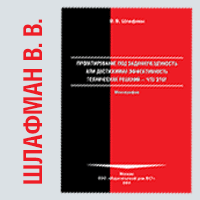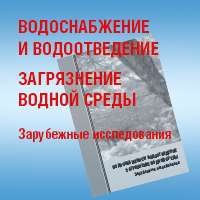№8|2025
WASTEWATER TREATMENT
UDC 628.356.324:532.5
DOI 10.35776/VST.2025.08.01
Calculation of the longitudinal dispersion coefficient and number of cells in the model of series-connected reactors Part
1. Review and engineering analysis of methods
Summary
A review and comparative analysis of engineering methods for calculating the longitudinal dispersion coefficient and the equivalent number of cells in a model of series-connected reactors used to describe hydrodynamics in aeration tanks are presented. Both empirical and semi-empirical formulas (B. Chambers and G. L. Jones, K. L. Murphy and B. I. Boyko, P. Harremoes, K. Fujie, and others) and dimensional and substantiated models (B. M. Khudenko and E. A. Shpirt, O. Potier, and Y. Le Moullec) are considered. The classification of methods by the type of data used in calculations and by the degree of sensitivity to geometric and aerodynamic parameters is given. The criteria for the applicability of approaches at different stages of design, simulation and upgrade of the wastewater treatment facilities are formulated. The paper represents the first part of two articles and considers the calculation and interpretation of the number of cells in bioreactors. The second part will be on the practical application of methods by the example of aeration tanks of various configurations.
Key words
wastewater , bioreactor , hydrodynamics , longitudinal dispersion coefficient , series-connected reactor model , cell number
For citation: Kolbasov G. A., Korolev M. A., Raff P. A., Usmanov R. R. Calculation of the longitudinal dispersion coefficient and number of cells in the model of series-connected reactors. Part 1. Review and engineering analysis of methods. Vodosnabzhenie i Sanitarnaia Tekhnika, 2025, no. 8, pp. 6–12. DOI: 10.35776/VST.2025.08.01. (In Russian).
The further text is accessible on a paid subscription.
For authorisation enter the login/password.
Or subscribe
REFERENCES
- Levenspiel O. Chemical reaction engineering. 3rd ed. New York: John Wiley & Sons, 1999, 668 p.
- Makinia J. Mathematical modelling and computer simulation of activated sludge systems. 1st ed. IWA Publishing, 2010, 408 p.
- Fogler H. S. Elements of chemical reaction engineering. 5th ed. Boston: Pearson Education, 2016, 958 p.
- Murphy K. L., Timpany P. L. Design and analysis of mixing for an aeration tank. Journal of Environmental Engineering, ASCE, 1967, v. 93 (5), pp. 1–15.
- Villermaux J. Génie de la réactionchimique. Paris: Tec & Doc, 1993, 446 p.
- Makinia J., Wells S. A. Evaluation of empirical formulae for estimation of the longitudinal dispersion in activated sludge reactors. Water Research, 2005, v. 39, pp. 1533–1542.
- Murphy K., Boyko B. Longitudinal mixing in spiral flow aeration tanks. Journal of the Sanitary Engineering Division, American Society of Civil Engineers, 1970, v. 96 (2), pp. 211–221.
- Harremoes P. Dimensionless analysis of circulation, mixing and oxygenation in aeration tanks. Progress in Water Technology, 1979, v. 11 (3), pp. 49–57.
- Fujie K., Sekizawa T., Kubota H. Liquid mixing in activated sludge aeration tank. Journal of Fermentation Technology, 1983, v. 61, pp. 295–304.
- Khudenko B. M., Shpirt E. A. Hydrodynamic parameters of diffused air systems. Water Research, 1986, v. 20, pp. 905–915.
- Chambers B., Jones G. L. Optimisation and upgrading of activated sludge plants by efficient process design. Water Science and Technology, 1988, v. 20 (4/5), pp. 121–132.
- Данилович Д. А., Эпов А. Н. Расчет и технологическое проектирование процессов и сооружений удаления азота и фосфора из городских сточных вод. – М., 2020. 225 с.
Danilovich D. A., Epov A. N. Raschet i tekhnologicheskoe proektirovanie protsessov i sooruzhenii udaleniia azota i fosfora iz gorodskikh stochnykh vod [Calculation and process design of the facilities for removing nitrogen and phosphorus from municipal wastewater. Moscow, 2020, 225 p.]. - Potier O., Leclerc J.-P., Pons M. N. Influence of geometrical and operational parameters on the axial dispersion in an aerated channel reactor. Water Research, 2005, v. 39, pp. 4454–4462.
- Le Moullec Y., Potier O., Gentric C., Leclerc J.-P. A general correlation to predict axial dispersion coefficients in aerated channel reactors. Water Research, 2008, v. 42, pp. 1767–1777.
- Henze M., Gujer W., Mino T., Loosdrecht M. C. M. Activated sludge models ASM1, ASM2, ASM2d and ASM3. IWA Publishing, 2000, 121 p.
- Zima P., Makinia J., Swinarski M., Czerwionka K. Combining CFD with biokinetic models for predicting ammonia and phosphate behavior in aeration tanks. Water Environment Research, 2009, v. 81, pp. 2353–2362.
- Coen F., Petersen B., Vanrolleghem P. A., Vanderhaegen B., Henze M. Model-based characterization of hydraulic, kinetic and influent properties of an industrial WWTP. Water Science and Technology, 1998, v. 37 (12), pp. 317–326.
- Zima P., Makinia J., Swinarski M., Czerwionka K. Effects of different hydraulic models on predicting longitudinal profiles of reactive pollutants in activated sludge reactors. Water Science and Technology, 2008, v. 58 (3), pp. 555–561.






